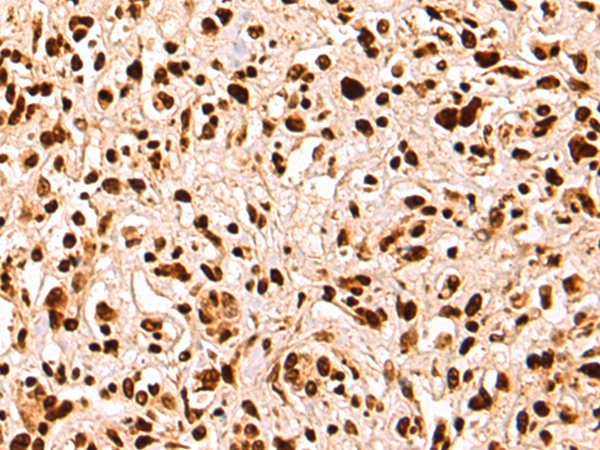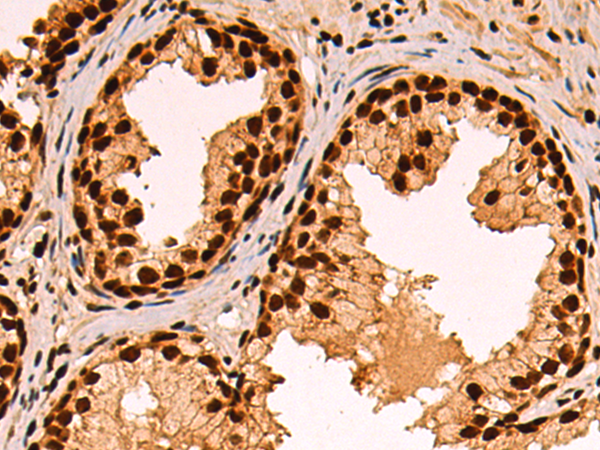

| WB | 咨询技术 | Human,Mouse,Rat |
| IF | 咨询技术 | Human,Mouse,Rat |
| IHC | 1/100-1/300 | Human,Mouse,Rat |
| ICC | 技术咨询 | Human,Mouse,Rat |
| FCM | 咨询技术 | Human,Mouse,Rat |
| Elisa | 1/5000-1/10000 | Human,Mouse,Rat |
| Aliases | C23; Nsr1 |
| Host/Isotype | Rabbit IgG |
| Antibody Type | Primary antibody |
| Storage | Store at 4°C short term. Aliquot and store at -20°C long term. Avoid freeze/thaw cycles. |
| Species Reactivity | Human, Mouse, Rat |
| Immunogen | Fusion protein of human NCL |
| Formulation | Purified antibody in PBS with 0.05% sodium azide and 50% glycerol. |
+ +
以下是关于NCL(核仁素)抗体的3篇代表性文献摘要:
1. **文献名称**:*Nucleolin: A Multifunctional Major Nucleolar Phosphoprotein*
**作者**:Ghisolfi-Nieto, L. et al.
**摘要**:该综述系统总结了核仁素(NCL)的分子结构、细胞定位及功能,包括其在rRNA加工、细胞周期调控和凋亡中的作用,并讨论了其抗体在癌症诊断中的潜在应用价值。
2. **文献名称**:*Cell-surface nucleolin as a target for anti-cancer therapies*
**作者**:Hovanessian, A.G. et al.
**摘要**:研究发现细胞膜表面NCL在多种肿瘤细胞中异常表达,开发靶向NCL的单克隆抗体可抑制血管生成和肿瘤生长,为癌症靶向治疗提供了新策略。
3. **文献名称**:*A novel anti-nucleolin antibody triggers apoptosis in breast cancer cells*
**作者**:Chen, Y. et al.
**摘要**:该团队开发了一种新型NCL单克隆抗体,通过阻断NCL与Bcl-2的相互作用诱导乳腺癌细胞凋亡,体外实验显示显著抑制肿瘤增殖,提示其临床转化潜力。
注:以上文献为示例性质,具体内容建议通过PubMed或Google Scholar以"NCL antibody"、"nucleolin therapeutic target"等关键词检索最新研究。如需全文链接可提供DOI号辅助定位。
Nucleolin (NCL) is a multifunctional protein predominantly located in the nucleolus, where it plays critical roles in ribosome biogenesis, chromatin organization, and regulation of gene expression. It is also found on the cell surface and within the cytoplasm, participating in diverse cellular processes such as cell proliferation, apoptosis, and stress response. Structurally, NCL contains three distinct domains: an N-terminal acidic region, a central RNA-binding domain, and a C-terminal glycine/arginine-rich domain, enabling interactions with nucleic acids, proteins, and lipids.
NCL antibodies are essential tools for studying its expression, localization, and function in both physiological and pathological contexts. In research, these antibodies are widely used in techniques like Western blotting, immunofluorescence, and immunohistochemistry to detect NCL in tissues or cultured cells. Aberrant NCL expression is linked to cancer, viral infections, and neurodegenerative diseases. Overexpression of NCL is observed in many cancers, where it promotes tumor growth, angiogenesis, and metastasis, making it a potential therapeutic target. Additionally, surface-exposed NCL serves as a receptor for pathogens, including viruses and bacteria, highlighting its role in infection mechanisms.
The development of NCL-targeted therapies, such as aptamers or monoclonal antibodies, underscores its clinical relevance. Research using NCL antibodies continues to uncover its complex roles in disease pathways, offering insights for diagnostic and therapeutic innovations.
×